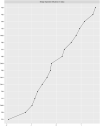Connecting the dots: A network approach to post-traumatic stress symptoms in Chinese healthcare workers during the peak of the Coronavirus Disease 2019 outbreak
- PMID: 33434296
- PMCID: PMC8013316
- DOI: 10.1002/smi.3027
Connecting the dots: A network approach to post-traumatic stress symptoms in Chinese healthcare workers during the peak of the Coronavirus Disease 2019 outbreak
Erratum in
-
Corrigendum.Stress Health. 2022 Feb;38(1):180-181. doi: 10.1002/smi.3113. Epub 2021 Nov 27. Stress Health. 2022. PMID: 34837724 Free PMC article. No abstract available.
Abstract
Healthcare workers are at elevated risk to develop symptoms of post-traumatic stress disorder (PTSD) in response to an outbreak of a highly infectious disease. The current study set-out to model the complex interrelations between PTSD symptoms during the peak of the Coronavirus Disease 2019 outbreak in 291 Chinese healthcare workers and 291 matched control cases that were selected from the general population. For this purpose, we estimated regularized partial correlation networks. Within the network of healthcare workers, we observed a central role for avoidance of reminders of the traumatic event, physiological cue reactivity, anger/irritability, re-experiencing, and startle. We identified three clusters of closely interconnected PTSD symptoms in healthcare workers, consisting of (a) symptoms of re-experiencing and anxious arousal, (b) symptoms of avoidance and amnesia and (c) symptoms of emotional numbing and dysphoric arousal. Respectively, startle, avoidance of reminders and feeling detached emerged as bridging nodes in these communities. Although yielding highly similar network models, the PTSD symptom structure of healthcare workers showed several unique features compared to the matched control sample. This is informative for interventions aimed at targeting PTSD symptoms in healthcare workers in the context of a public health emergency.
Keywords: COVID-19; PTSD; healthcare workers; network analysis; stress; symptom structure.
© 2021 John Wiley & Sons Ltd.
Figures



Similar articles
-
Mapping post-traumatic stress disorder symptoms and quality of life among residents of Wuhan, China after the COVID-19 outbreak: A network perspective.J Affect Disord. 2022 Dec 1;318:80-87. doi: 10.1016/j.jad.2022.08.074. Epub 2022 Aug 27. J Affect Disord. 2022. PMID: 36030998 Free PMC article.
-
Prevalence and factors associated with post-traumatic stress disorder in healthcare workers exposed to COVID-19 in Wuhan, China: a cross-sectional survey.BMC Psychiatry. 2021 Nov 15;21(1):572. doi: 10.1186/s12888-021-03589-1. BMC Psychiatry. 2021. PMID: 34781901 Free PMC article.
-
Possible posttraumatic stress disorder in Chinese frontline healthcare workers who survived COVID-19 6 months after the COVID-19 outbreak: prevalence, correlates, and symptoms.Transl Psychiatry. 2021 Jul 5;11(1):374. doi: 10.1038/s41398-021-01503-7. Transl Psychiatry. 2021. PMID: 34226510 Free PMC article.
-
Prevalence and Determinants of Immediate and Long-Term PTSD Consequences of Coronavirus-Related (CoV-1 and CoV-2) Pandemics among Healthcare Professionals: A Systematic Review and Meta-Analysis.Int J Environ Res Public Health. 2021 Feb 23;18(4):2182. doi: 10.3390/ijerph18042182. Int J Environ Res Public Health. 2021. PMID: 33672257 Free PMC article.
-
The prevalence of post-traumatic stress disorder related symptoms in Coronavirus outbreaks: A systematic-review and meta-analysis.J Affect Disord. 2021 Mar 1;282:527-538. doi: 10.1016/j.jad.2020.12.188. Epub 2021 Jan 2. J Affect Disord. 2021. PMID: 33433382 Free PMC article.
Cited by
-
Identifying post-traumatic stress symptom typologies in clinical and non-clinical healthcare staff: a latent profile analysis.Eur J Psychotraumatol. 2024;15(1):2351323. doi: 10.1080/20008066.2024.2351323. Epub 2024 May 16. Eur J Psychotraumatol. 2024. PMID: 38753619 Free PMC article.
-
Trauma exposure and the PTSD symptoms of college teachers during the peak of the COVID-19 outbreak.Stress Health. 2021 Dec;37(5):914-927. doi: 10.1002/smi.3049. Epub 2021 Apr 17. Stress Health. 2021. PMID: 33837651 Free PMC article.
-
Relationships between psychopathological symptoms, pandemic-related stress, perceived social support, and COVID-19 infection history: a network analysis in Chinese college students.Front Psychiatry. 2024 Feb 2;15:1340101. doi: 10.3389/fpsyt.2024.1340101. eCollection 2024. Front Psychiatry. 2024. PMID: 38370557 Free PMC article.
-
Mapping post-traumatic stress disorder symptoms and quality of life among residents of Wuhan, China after the COVID-19 outbreak: A network perspective.J Affect Disord. 2022 Dec 1;318:80-87. doi: 10.1016/j.jad.2022.08.074. Epub 2022 Aug 27. J Affect Disord. 2022. PMID: 36030998 Free PMC article.
-
Delayed antiviral medical treatment increased PTSD development among COVID-19 hospitalized patients: Greater impact in males.Asian J Psychiatr. 2022 Sep;75:103216. doi: 10.1016/j.ajp.2022.103216. Epub 2022 Jul 16. Asian J Psychiatr. 2022. PMID: 35870310 Free PMC article. No abstract available.
References
-
- Adelson, J. L. (2013). Educational research with real data: Reducing selection bias with propensity score analysis. Practical Assessment Research & Evaluation, 18, 15. 10.7275/4nr3-nk33 - DOI
-
- American Psychiatric Association . (2000). Diagnostic and statistical manual of mental disorders. (4th ed. Text Revision). Washington, DC: American Psychiatric Association.
-
- American Psychiatric Association . (2013). Diagnostic and statistical manual of mental disorders (5th ed.). Arlington, VA: American Psychiatric Association.
-
- Bartels, L. , Berliner, L. , Holt, T. , JensenJungbluth, T. N. , Plener, P. , Risch, E. , … Sachser, C. (2019). The importance of the DSM‐5 posttraumatic stress disorder symptoms of cognition and mood in traumatized children and adolescents: Two network approaches. The Journal of Child Psychology and Psychiatry, 60, 545–554. - PubMed
MeSH terms
Grants and funding
LinkOut - more resources
Full Text Sources
Other Literature Sources
Medical

